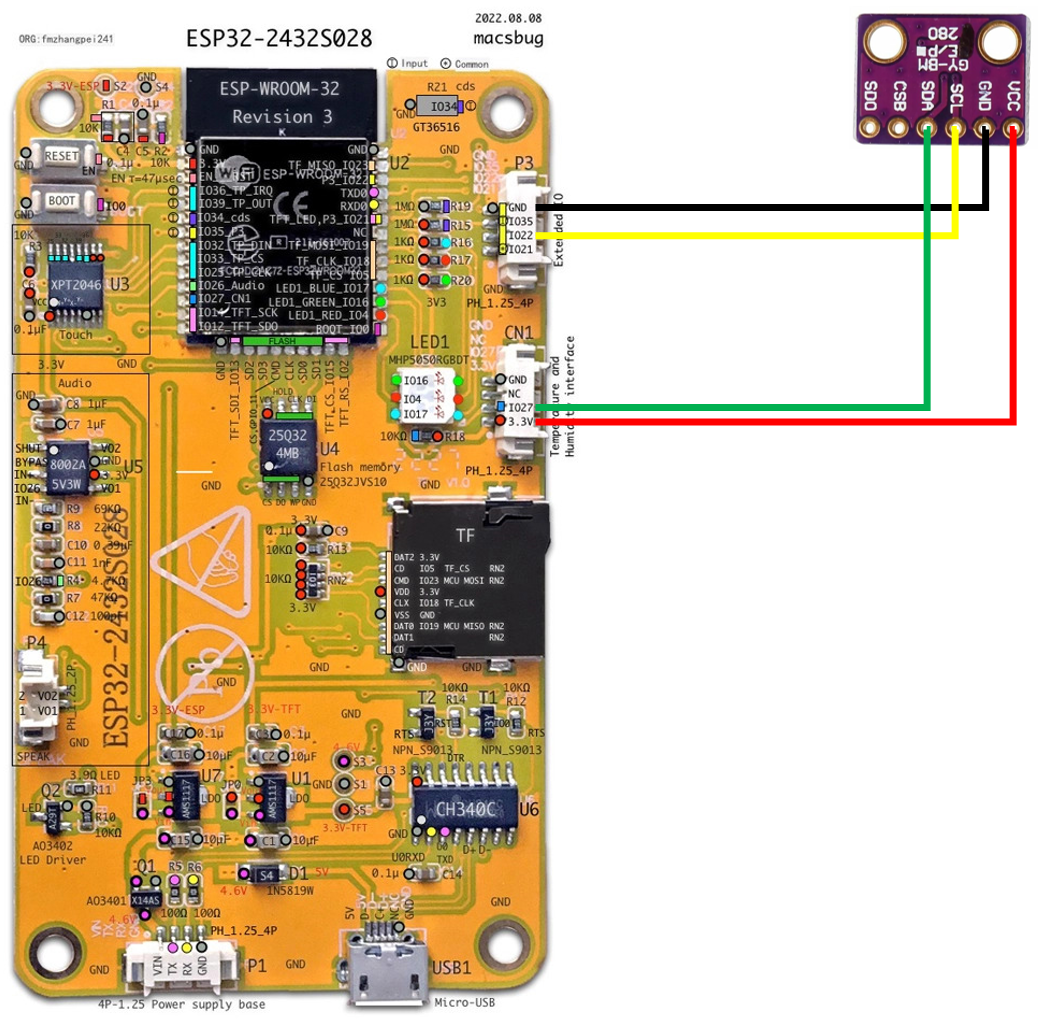This repository contains some experimental setup for using the esp32-2432s028 develoment board with tft display within Home Assistant. Only a few gpio pins are exposed and usable, but by using I²C you could use a MCP23017 module to add additional ports.
Two separate SPI busses are being used for the display and the touchscreen.
spi:
- id: lcd
clk_pin: GPIO14
mosi_pin: GPIO13
miso_pin: GPIO12
- id: touch
clk_pin: GPIO25
mosi_pin: GPIO32
miso_pin: GPIO39The esp32-2432s028 has an ili9341 display that can be used via the lcd SPI bus:
display:
- platform: ili9341
model: TFT 2.4
spi_id: lcd
cs_pin: 15
dc_pin: 2
led_pin: 21
lambda: |-
...To add touch functionalities, a touchscreen component should be added via the touch SPI bus:
touchscreen:
platform: xpt2046
spi_id: touch
cs_pin: 33
interrupt_pin: 36
update_interval: 50ms
report_interval: 1s
threshold: 400
calibration_x_min: 3860
calibration_x_max: 280
calibration_y_min: 340
calibration_y_max: 3860
swap_x_y: false
The default gpio pins for I2C on an ESP32 are GPIO21 and GPIO22. Both of them are exposed in the extended IO connector (P3), but apparently GPIO21 is also used as a led pin in the lcd SPI bus, so it looks as if this gpio pin is somehow useless on the extended IO connector. GPIO35 which is also exposed in the extended IO connector can only be used for input, so also useless for I2C. Luckily there is another connector with GPIO27, which makes it possible to setup an I2C bus.
i2c:
sda: GPIO27
scl: GPIO22
scan: true
id: bus_asubstitutions:
devicename: "esp32-2432s028"
ssid: Esp32-2432S028 Fallback Hotspot
static_ip: 192.168.0.44
gateway: 192.168.0.1
subnet: 255.255.255.0
packages:
wifi: !include common/wifi.yaml
esphome:
name: $devicename
build_path: ./build/$devicename
esp32:
board: esp32dev
framework:
type: arduino
logger:
api:
ota:
captive_portal:
spi:
- id: lcd
clk_pin: GPIO14
mosi_pin: GPIO13
miso_pin: GPIO12
- id: touch
clk_pin: GPIO25
mosi_pin: GPIO32
miso_pin: GPIO39
i2c:
sda: GPIO27
scl: GPIO22
scan: true
id: bus_a
color:
- id: my_red
red: 100%
green: 0%
blue: 0%
- id: my_orange
red: 100%
green: 50%
blue: 0%
- id: my_yellow
red: 100%
green: 100%
blue: 0%
- id: my_green
red: 0%
green: 100%
blue: 0%
- id: my_blue
red: 0%
green: 0%
blue: 100%
- id: my_teal
red: 0%
green: 100%
blue: 100%
- id: my_gray
red: 70%
green: 70%
blue: 70%
- id: my_white
red: 100%
green: 100%
blue: 100%
font:
- file: "Helvetica.ttf"
id: helvetica_48
size: 48
- file: "Helvetica.ttf"
id: helvetica_36
size: 36
- file: "Helvetica.ttf"
id: helvetica_24
size: 24
- file: "Helvetica.ttf"
id: helvetica_12
size: 12
image:
- file: "power-off-button.png"
id: on_off_button
- file: "radio-station.png"
id: radio
binary_sensor:
- platform: status
name: "Node Status"
id: system_status
- platform: touchscreen
name: Power
x_min: 30
x_max: 90
y_min: 20
y_max: 80
- platform: touchscreen
name: Music
x_min: 150
x_max: 210
y_min: 20
y_max: 80
time:
- platform: homeassistant
id: esptime
text_sensor:
- platform: template
# name: Uptime Human Readable
id: uptime_human
icon: mdi:clock-start
internal: True
- platform: wifi_info
ip_address:
# name: ESP IP Address
id: ip_address
sensor:
- platform: uptime
# name: Uptime Sensor
internal: True
id: uptime_sensor
update_interval: 1s
on_raw_value:
then:
- text_sensor.template.publish:
id: uptime_human
state: !lambda |-
int seconds = round(id(uptime_sensor).raw_state);
int days = seconds / (24 * 3600);
seconds = seconds % (24 * 3600);
int hours = seconds / 3600;
seconds = seconds % 3600;
int minutes = seconds / 60;
seconds = seconds % 60;
return (
("Uptime ") +
(days ? to_string(days) + "d " : "") +
(hours ? to_string(hours) + "h " : "") +
(minutes ? to_string(minutes) + "m " : "") +
(to_string(seconds) + "s")
).c_str();
- platform: wifi_signal
# name: "WiFi Signal Sensor"
internal: True
id: wifi_signal_sensor
update_interval: 5s
- platform: bmp280
temperature:
name: "Temperatuur"
unit_of_measurement: °C
accuracy_decimals: 1
id: "bme_temperature"
pressure:
name: "Luchtdruk"
unit_of_measurement: hPa
accuracy_decimals: 0
id: "bme_humidity"
address: 0x76
update_interval: 30s
display:
- platform: ili9341
model: TFT 2.4
spi_id: lcd
cs_pin: 15
dc_pin: 2
led_pin: 21
lambda: |-
int hs = it.get_width() / 2; // Horizontal Spacing = text data horizontal center point
int hq = it.get_width() / 4; // text data horizontal center for two vertical lines
int vs = it.get_height() / 8; // Vertical Center = text data vertical center point = how many lines
int line_gap = 21; // distance of line from center of data text
it.rectangle(0, 0, it.get_width(), it.get_height(), id(my_blue));
it.rectangle(0, 20, it.get_width(), it.get_height(), id(my_blue));
it.strftime(5, 5, id(helvetica_12), id(my_white), TextAlign::TOP_LEFT, "%H:%M:%S", id(esptime).now());
it.print(hs, 5, id(helvetica_12), id(my_blue), TextAlign::TOP_CENTER, "${devicename}"); //print title
if (id(system_status).state) {
it.print(it.get_width()-5, 5, id(helvetica_12), id(my_green), TextAlign::TOP_RIGHT, "Online");
}
else {
it.print(it.get_width()-5, 5, id(helvetica_12), id(my_red), TextAlign::TOP_RIGHT, "Offline");
}
it.line(0, it.get_height()-20, it.get_width(), it.get_height()-20, id(my_blue)); // line across bottom above footer text
it.printf(5, it.get_height()-3, id(helvetica_12), id(my_gray), TextAlign::BOTTOM_LEFT, "%s", id(uptime_human).state.c_str());
it.printf(hs, it.get_height()-3, id(helvetica_12), id(my_gray), TextAlign::BOTTOM_CENTER, "%.0fdBm", id(wifi_signal_sensor).state);
it.printf(it.get_width()-5, it.get_height()-3, id(helvetica_12), id(my_gray), TextAlign::BOTTOM_RIGHT, "%s", id(ip_address).state.c_str());
it.image(hq - 25, 50, id(on_off_button));
it.image(3*hq - 25, 50, id(radio));
it.line(0, vs * 3, it.get_width(), vs * 3, id(my_blue));
it.print(hs, vs * 3 + line_gap, id(helvetica_24), id(my_white), TextAlign::CENTER, "BME280 sensor");
it.line(0, vs * 4, it.get_width(), vs * 4, id(my_blue));
it.print(hq, vs * 5, id(helvetica_12), id(my_white), TextAlign::CENTER, "Temperature:");
it.printf(3*hq, vs * 5, id(helvetica_12), id(my_white), TextAlign::CENTER, "%.1f°C", id(bme_temperature).state);
it.print(hq, vs * 6, id(helvetica_12), id(my_white), TextAlign::CENTER, "Pressure:");
it.printf(3*hq, vs * 6, id(helvetica_12), id(my_white), TextAlign::CENTER, "%.0fhPa", id(bme_humidity).state);
touchscreen:
platform: xpt2046
spi_id: touch
cs_pin: 33
interrupt_pin: 36
update_interval: 50ms
report_interval: 1s
threshold: 400
calibration_x_min: 3860
calibration_x_max: 280
calibration_y_min: 340
calibration_y_max: 3860
swap_x_y: false
# Exposed switches.
switch:
- platform: restart
name: ESP32-2432S028 Restart

